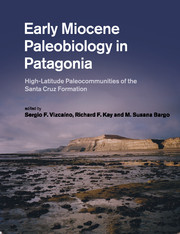Book contents
- Early Miocene Paleobiology in Patagonia
- Frontispiece
- Early Miocene Paleobiology in Patagonia
- Copyright page
- Contents
- Contributors
- Preface
- 1 Background for a paleoecological study of the Santa Cruz Formation (late Early Miocene) on the Atlantic Coast of Patagonia
- 2 Tephrochronology of the Miocene Santa Cruz and Pinturas Formations, Argentina
- 3 Absolute and relative ages of fossil localities in the Santa Cruz and Pinturas Formations
- 4 Sedimentology and paleoenvironment of the Santa Cruz Formation
- 5 Oysters from the base of the Santa Cruz Formation (late Early Miocene) of Patagonia
- 6 Ichnology of distal overbank deposits of the Santa Cruz Formation (late Early Miocene): paleohydrologic and paleoclimatic significance
- 7 Fossil plant studies from late Early Miocene of the Santa Cruz Formation: paleoecology and paleoclimatology at the passive margin of Patagonia, Argentina
- 8 Amphibians and squamate reptiles from the Santa Cruz Formation (late Early Miocene), Santa Cruz Province, Argentina: paleoenvironmental and paleobiological considerations
- 9 Diversity and paleobiology of the Santacrucian birds
- 10 Paleoecology of the Paucituberculata and Microbiotheria (Mammalia, Marsupialia) from the late Early Miocene of Patagonia
- 11 Paleoecology of the mammalian carnivores (Metatheria, Sparassodonta) of the Santa Cruz Formation (late Early Miocene)
- 12 Paleobiology of Santacrucian glyptodonts and armadillos (Xenarthra, Cingulata)
- 13 Paleobiology of the Santacrucian sloths and anteaters (Xenarthra, Pilosa)
- 14 Paleobiology of Santacrucian native ungulates (Meridiungulata: Astrapotheria, Litopterna and Notoungulata)
- 15 Paleobiology of Santacrucian caviomorph rodents: a morphofunctional approach
- 16 Paleobiology of Santacrucian primates
- 17 A review of the paleoenvironment and paleoecology of the Miocene Santa Cruz Formation
- Index
17 - A review of the paleoenvironment and paleoecology of the Miocene Santa Cruz Formation
Published online by Cambridge University Press: 05 June 2013
- Early Miocene Paleobiology in Patagonia
- Frontispiece
- Early Miocene Paleobiology in Patagonia
- Copyright page
- Contents
- Contributors
- Preface
- 1 Background for a paleoecological study of the Santa Cruz Formation (late Early Miocene) on the Atlantic Coast of Patagonia
- 2 Tephrochronology of the Miocene Santa Cruz and Pinturas Formations, Argentina
- 3 Absolute and relative ages of fossil localities in the Santa Cruz and Pinturas Formations
- 4 Sedimentology and paleoenvironment of the Santa Cruz Formation
- 5 Oysters from the base of the Santa Cruz Formation (late Early Miocene) of Patagonia
- 6 Ichnology of distal overbank deposits of the Santa Cruz Formation (late Early Miocene): paleohydrologic and paleoclimatic significance
- 7 Fossil plant studies from late Early Miocene of the Santa Cruz Formation: paleoecology and paleoclimatology at the passive margin of Patagonia, Argentina
- 8 Amphibians and squamate reptiles from the Santa Cruz Formation (late Early Miocene), Santa Cruz Province, Argentina: paleoenvironmental and paleobiological considerations
- 9 Diversity and paleobiology of the Santacrucian birds
- 10 Paleoecology of the Paucituberculata and Microbiotheria (Mammalia, Marsupialia) from the late Early Miocene of Patagonia
- 11 Paleoecology of the mammalian carnivores (Metatheria, Sparassodonta) of the Santa Cruz Formation (late Early Miocene)
- 12 Paleobiology of Santacrucian glyptodonts and armadillos (Xenarthra, Cingulata)
- 13 Paleobiology of the Santacrucian sloths and anteaters (Xenarthra, Pilosa)
- 14 Paleobiology of Santacrucian native ungulates (Meridiungulata: Astrapotheria, Litopterna and Notoungulata)
- 15 Paleobiology of Santacrucian caviomorph rodents: a morphofunctional approach
- 16 Paleobiology of Santacrucian primates
- 17 A review of the paleoenvironment and paleoecology of the Miocene Santa Cruz Formation
- Index
Summary
The paleoenviroment and paleoecology of the Santa Cruz Formation (SCF) is summarized, combining the data from the chapters of this book and new examination of the community structure of the vertebrate fauna using modern analogs. Emphasis is placed on the SCF outcrops along the coastal Atlantic between about 50.3° and 51.6° S and their faunas (~17.9 to 16.2 Ma; Santacrucian SALMA). New data on the sedimentology, the ichnology, and the flora and fauna of the SCF is particularly strong for the lower parts of the SCF south of the Río Coyle (FL 1–7). FL 1–7 (~17.4 to 17.5 Ma) is analogous to a single modern fauna of limited geographic and temporal scope. As paleolatitude during Santacrucian times was the same as that of today, FL 1–7 was extratropical and had highly seasonal day lengths. The Andes had not risen to a sufficient altitude to block westerly winds and moisture from reaching the Atlantic coast. New dates for FL 1–7 indicate that the mid-Miocene global climatic cooling had not yet begun. Several taxa recovered at FL 1–7 or in nearby penecontemporaneous levels (e.g. palm trees, the frog Calyptocephalella, the lizard Tupinambis, the anteater Protamandua, and the primate Homunculus) strongly indicate that the climate of FL 1–7 was much warmer and wetter than today. The overall mammalian species richness and niche composition, expressed as percentages of arboreal or scansorial, frugivorous, and grazing, suggest that overall rainfall was in the range of 1000 to 1500 mm per annum. Occurrence of trees and forest-dwelling birds and mammals (porcupines, spiny rats, sloths, scansorial marsupials, and monkeys) supports this conclusion. The occurrence of calcareous root casts in paleosols indicates high seasonality in rainfall with cool wet winters and dry warm summers. Grasses were also present, and a number of vertebrate taxa (giant terrestrial birds, many notoungulates, glyptodonts, and armadillos) appear to have been adapted to open environments. Consideration of sedimentologic, ichnologic, floral, and faunal elements taken together suggests a landscape for FL 1–7 consisting of a mosaic of open temperate humid and semi-arid forests, with ponds in some areas and seasonal flooding in others, no doubt promoting the formation of marshlands with a mixture of grasses and forbes.
- Type
- Chapter
- Information
- Early Miocene Paleobiology in PatagoniaHigh-Latitude Paleocommunities of the Santa Cruz Formation, pp. 331 - 365Publisher: Cambridge University PressPrint publication year: 2012
- 41
- Cited by



